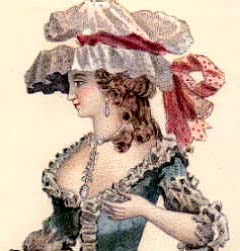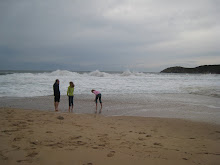 Sunday morning in Liverpool we arrived at the Albert Dock just in time to climb aboard the bright yellow minibus for the National Trust tour of the childhood homes of John Lennon and Paul McCartney. The four of us took seats in the back; in front of us were a group of women in their 60s, a 60ish couple, and a mother (60ish) and daughter (30ish, 7 months pregnant). When the driver put on his seat belt he asked if we were all Beatles fans. E and G looked at us plaintively while everyone else mumbled a dutiful yes. Then he started the music.
Sunday morning in Liverpool we arrived at the Albert Dock just in time to climb aboard the bright yellow minibus for the National Trust tour of the childhood homes of John Lennon and Paul McCartney. The four of us took seats in the back; in front of us were a group of women in their 60s, a 60ish couple, and a mother (60ish) and daughter (30ish, 7 months pregnant). When the driver put on his seat belt he asked if we were all Beatles fans. E and G looked at us plaintively while everyone else mumbled a dutiful yes. Then he started the music.We drove through Liverpool in the bus--covered in photos of the young John and Paul--to the strains of She Loves You and Penny Lane, Strawberry Fields and Imagine. The bus let us out at Lennon's home. Colin, the caretaker who lives on site, met us in the front garden and gave us what turned out to be a cultural history of postwar Liverpool and the Lennon family: the bombings in 1940 during which Lennon was born; the father who ran off with the merchant marine; the aunt who took in boarders to afford the middle-class house. We went into the kitchen and it was stocked with old tins of PG Tips and Heinz baked beans. The good china was locked up in the cabinet in the front room; there were chrysanthemums in cut glass on the window sill. Colin the caretaker told us how cold the house would get in the winter, how young John's aunt disapproved of George Harrison's Elvis pompadour and Liverpudlian accent. At Paul's house--smaller, shabbier, more working class--the caretaker told funny stories about other visitors and family stories about Paul and his father and brother.
Two days later we were in Grasmere. I wrote my undergraduate thesis on Wordsworth and the French Revolution (nerds are us), and so visits to the Wordsworth houses--Dove Cottage, where he was a bohemian rebel, and Rydal Mount, where he out-Establishmented the Establishment--were the main items on the agenda.
At Dove Cottage, our docent had taken on the depressive atmosphere of the house. It was dark, low, cold, and damp. She was likewise. She recited her lines in each room with little or no elaboration and--E pointed out later--no hand gestures. The cottage smelled of the coal fires that still heat it (or don't). Atmospheric, yes. Informative, not so much. Rydal Mount was much the same: atmospheric--a pleasant, sunny house with views of the lake--but not terribly informative. Labels were glued to the wall under portraits: This copy of a painting in the National Portrait Gallery shows the Poet as a young man. This painting is of the Poet's great-great-great-granddaughter.
And so--we have come to the part where I lay my cards on the table--I have been thinking about storytelling. About how we tell stories, what we put in our stories, and what we leave out. What we think everyone knows, and what we think everyone ought to know. One evening in Grasmere we got behind a regional bus that ran between Windermere and Keswick. It was covered in advertisements for Dove Cottage. Go beyond the daffodils, ran the tag line, playing on Wordsworth's poem. Visit Dove Cottage.
Now, I have been beyond the daffodils. I can tell you stories about Wordsworth and his buddies that I would defy many other self-respecting poetry geeks to have at their fingertips. And I heard not one of those tales retold at Dove Cottage, or at Rydal Mount. The story they told was not of a young man who, by luck and chance and some measure of hard work but mostly being in the right place at the right time, ended up becoming A Famous Poet. Instead it was the story of How The Poet Sat Here, In This Spot Where You Are Now Standing, And Would You Like A Postcard With That.
In Liverpool--in our silly yellow bus with the giant black and white photos of Paul and John--we actually heard a story about how these young boys, or--as they said without a trace of self-consciousness, something I'll never master--lads, had the good luck to become the people we know as John Lennon and Paul McCartney. How they weren't terribly good students, and drove their parents crazy, and probably made an awful racket rehearsing.
Touring the childhood homes of the Beatles felt a little silly. After all, we're talking about our lifetimes, or our parents' (or, for E and G, their grandparents'), and I'm not even a big fan. Going to Wordsworth's houses, on the other hand, felt like a Proper Literary Pilgrimage, something I've been meaning to do for ever. And yet: it turned out silly was a gift. Silly meant that somebody at the National Trust had to think about what these house tours were going to be about. They couldn't be about Great Men: John hasn't been gone long enough, and Paul is still around, and neither of them found a cure for cancer (or wrote Tintern Abbey; we'll see how The Long and Winding Road holds up.). They had to be about life as it was lived there and then, how it felt and tasted and smelled. Up in Grasmere, the feeling seemed to be that the story would tell itself, that everyone already knew all about Wordsworth & Co, and that simply being in the Presence of the Poet's Life Mask (of which there was one; I was delighted, and confirmed in my suspicion that perhaps the Poet took himself just a tad too seriously) was enough. Would I visit both Wordsworth houses again? Absolutely; no question. Should the houses be on anyone's Lake District list? Yep. (Don't miss the lock of Wordsworth's hair upstairs in the back bedroom, overlooking the garden, at Dove Cottage.) Could the story told be more interesting? Yes. (But I'm not the one who has to figure out how to cycle thousands of people through those buildings. It's easy when you're sitting at your desk, difficult when you've got a busload of tourists who need to use the bathroom and will be in York by nightfall.)
And, for the record, I bought the postcard.






































It's a bit late to mention it now, but I really hope you tried the Sarah Nelson gingerbread shop next to the churchyard in Grasmere.
ReplyDeleteWe did try the gingerbread. Three times. And we brought some home. C, who doesn't even like gingerbread, loved it. It was the Food Highlight of the trip (a distant second was the Thai restaurant in Ambleside).
ReplyDeleteThe way to do it is to have someone really good and entertaining make a recording. I did it for our local scenic mountain tour and then in French and German (with native speakers). It is impossible for a tour guide to be good every day with the same script.
ReplyDelete